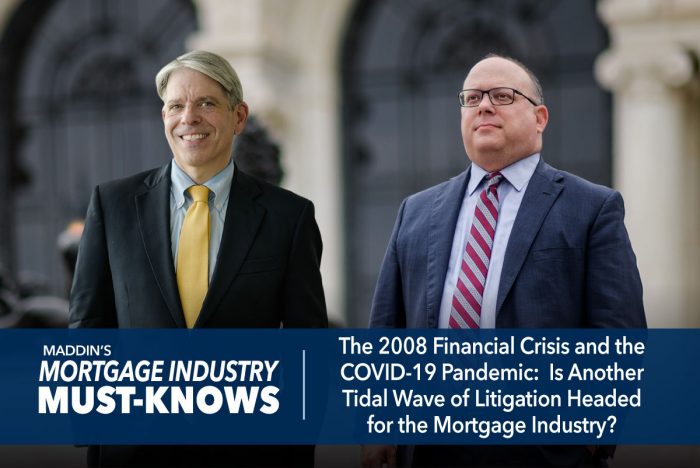
The 2008 Financial Crisis & the COVID-19 Pandemic: Is Another Tidal Wave of Litigation Headed for the Mortgage Industry?
By Martin S. Frenkel and Brian A. Nettleingham
The Great Recession of 2008 was one of the true cataclysmic economic events of the past century. It dramatically disrupted the mortgage finance industry. Millions of foreclosures and evictions. Large numbers of displaced homeowners. Massive regulatory investigations. New legislation. And even new terminology from robo-signing to zombie foreclosures to dual tracking. These concepts merely scratch the surface in describing the recession and its impacts. One impact that all in house counsel and the outside counsel who assist them will remember is the flood of resulting litigation. You name it, we saw it. Offensive borrower litigation, defensive borrower litigation, HOA/COA foreclosures, buy/back claims, RMBS litigation, nuisance and blight lawsuits, rampant title claims, large scale fraud cases, and everything in between. Some of us in the industry still wake up having nightmares from the trauma!
In light of the COVID-19 pandemic and the related increase in unemployment and extended forbearance periods, it begs the question: will we see even a shadow of the tidal wave of litigation that we witnessed during the Great Recession? Although only those with a crystal ball know the answer to this question, there are some observations worth making (particularly when at least 2.5 million homeowners are currently in forbearance). In the lead up to the building tsunami of litigation during the 2008 financial crisis, mortgage servicers’ loss mitigation and in house legal department litigation teams, and the tools at their disposal, were not initially as well staffed and robust at the outset of the crisis as they would become after adjusting to years of being flooded with litigation. Today, one wonders whether, after years of economic growth, low unemployment, and miniscule default rates and resulting foreclosures, have loss mitigation and in house litigation legal staffs naturally atrophied? If there is a COVID-19 post-moratoria tidal wave, how long will it take for loss mitigation and legal departments to ramp up to meet the challenge? Will the depth and breadth of economic disruption, the destruction brought upon certain industries which may take years to recover such as restaurants and hospitality, and potentially long term unemployment, all resulting from the pandemic deprive loss mitigation staffs of some of their most effective tools for avoiding foreclosure, namely loan modifications which are predicated on borrowers having income? Finally, if interest rates climb, will this limit the ability of servicers and borrowers to defer accrued balances as a balloon at the end of the loan term in the hope of a later refinance?
If all past is prologue, what are some observations about pitfalls from the last ramp up in mortgage servicing to address high levels of litigation of which we need to be aware now? In no particular order, some potential hazards to keep in mind are:
- Limitations associated with legacy technology, particularly regarding system interoperability and servicing transfers
- Having too few well-versed and well-trained witnesses and client settlement representatives
- Lost documents and/or delays in locating documents and other information which may cause significant damage to defenses or the ability to foreclose
- Having the need for “custom” data or other solutions during pending litigation (i.e. custom payoff and escrow calculations)
- Issues associated with a limited number of panel counsel and the “watering down” of those firms and the corresponding work product/results
- Failing to properly coordinate loss mitigation efforts (resulting in duplicative or overlapping loss mitigation communications to borrowers), or failing to coordinate those efforts with pending litigation, thereby creating potential defenses in a lawsuit
- Risks associated with a commoditized approach to settlement
- Having a lack of institutional knowledge and coordination across departments (i.e. legal, bankruptcy, loss mitigation, REO, credit reporting)
What are some additional litigation concerns specific to the nature of the pandemic and our response to it as an industry? Foreclosures occur in the normal course of business even in a healthy economy which have been stalled. Additional potential foreclosures resulting from the pandemic have also been halted. Upon the lifting of foreclosure moratoria, both tranches of foreclosures will begin. With so many mortgage foreclosures in “stasis,” it is likely there have been many escrow advances, other protective advances (such as to HOA/COA’s in super-lien states), forced placed insurance, and even partial payments by borrowers in forbearance which will wreak havoc on accounting of mortgage balances. One lesson from the 2008 financial crisis was that of the “accounting” defense to mortgage foreclosures. Simply stated, borrowers argued that the servicer failed to properly account for payments received, failed to provide proper notice of protective advances, or asserted that such advances were unnecessary – all leading to the conclusion that the borrower was not actually in default or that the servicer failed to provide appropriate notice of the “correct” amount due at default depriving the borrower of proper notice and cure remedies. These cases proved very time consuming and difficult to dispose of on a dispositive motion. However, where these cases did not predominate in the aftermath of the Great Recession as compare to other forms of litigation, the claim may become one of the primary assertions in a post-pandemic mortgage world.
Against this backdrop, there are a few takeaways which we offer:
- Consider increased hiring of default servicing and loss mitigation staff, with regular updates and training on COVID litigation trends
- Take steps to ensure that default servicing, foreclosure, and litigation channels are sufficiently scalable to handle a high default environment. This will help prevent legitimate claims from arising from default servicing and loss mitigation activities
- Create an expedited triage process for identifying and settling legitimate claims quickly, before significant legal costs are incurred and avoiding the potential for brand damage
- Take all necessary steps to ensure that third-party vendors are complying with necessary default servicing and loss mitigation processes
- Create processes for evaluating, defending (if necessary), and correcting claims relating to miscalculation of loan balances
- As these claims, including unique COVID-related claims, begin to surge, create a process for ensuring that your outside counsel network is employing coordinated defenses and strategies across jurisdictions, where possible
- Consider carefully how forbearance balances will be treated in bankruptcy
- Create audit processes for evaluating proper suspension of credit reporting during the forbearance period
Although we are hopeful that there will not be a COVID-related litigation surge, it seems appropriate (as it is likely that many foreclosure moratoria will expire by the end of the year) to begin planning for the worst.
This article has been featured in the Michigan Mortgage Lenders Association May Mortgage Pipeline Newsletter.

Martin S. Frenkel
Co-Chair of the Financial Services and Real Property Litigation Group, experienced business litigator, shareholder and executive committee member.
Phone: (248) 827-1891
Fax: (248) 359-6141
mfrenkel@maddinhauser.com

Brian A. Nettleingham
Shareholder in Maddin Hauser’s Financial Services and Real Property Litigation, Complex Litigation and Risk Advisory, and Banking Groups.
Phone: (248) 359-7503
Fax: (248) 359-7553
BNettleingham@maddinhauser.com
































